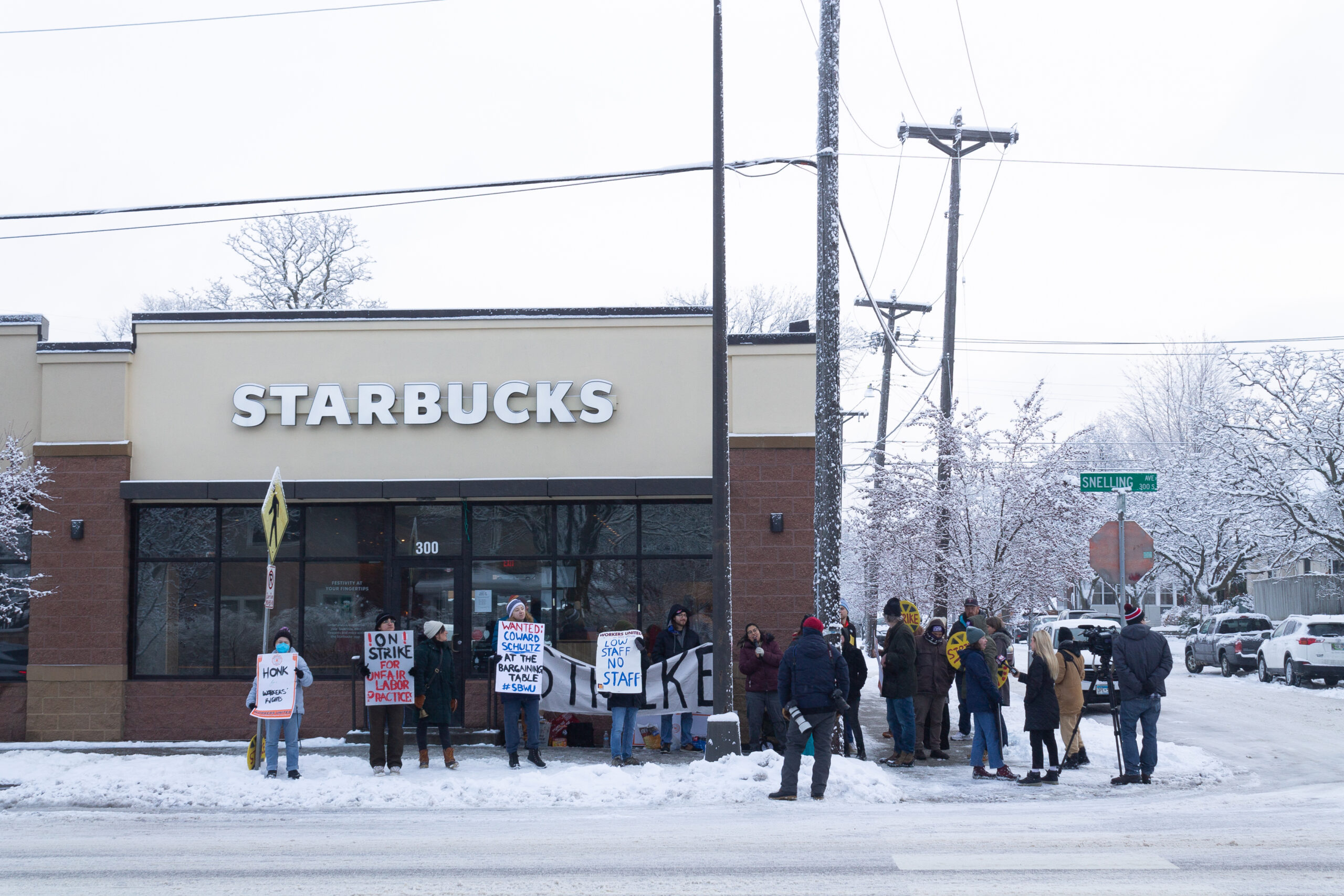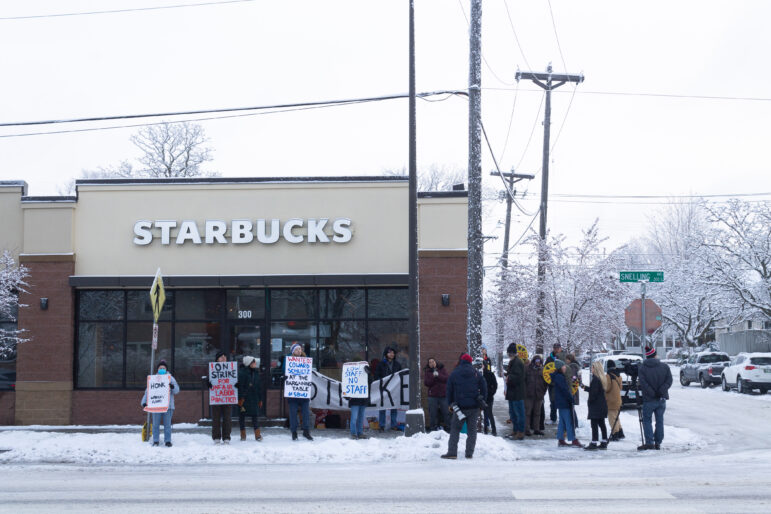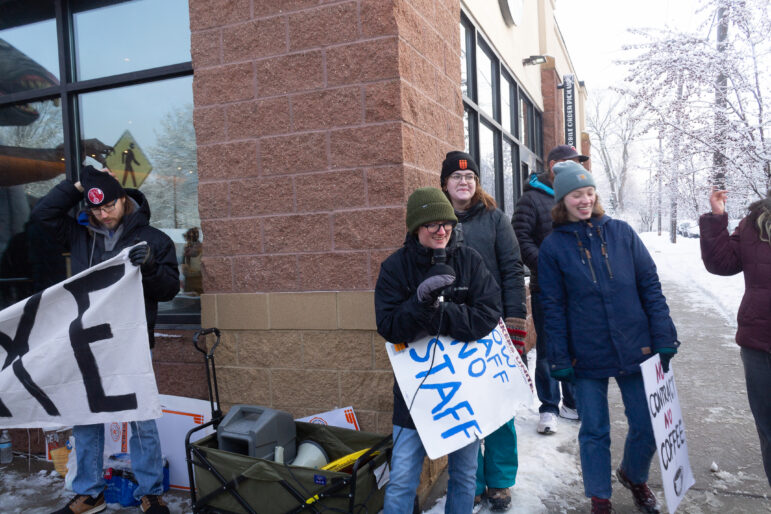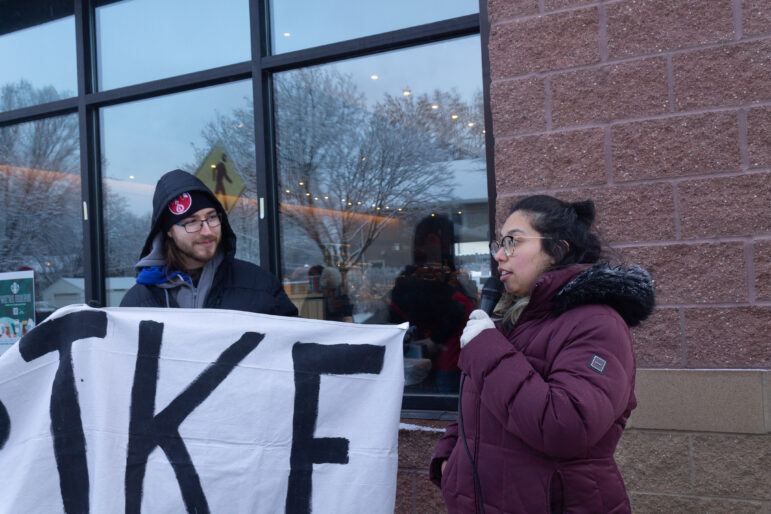
Starbucks workers on strike on outside of a shop in St. Paul, Minnesota. Photo by Isabela Escalona.

Share
Amid a historic unionizing campaign across the country, workers are continuing to organize despite Starbucks ‘soft’ union-busting tactics
“A lot of the union busting that we’re seeing is very quiet. It’s very mellow,” says Ethan Tinklenberg, a Starbucks worker, or “partner” as the company likes to refer employees. “It’s not them making us take off our union pins or our union hats. It’s cutting our hours slowly but surely, while not promoting union leaders, and spreading misinformation about the union in conversation—but not directly, but just sort of slipping it in there with everything they say.”
Tinklenberg is a leader in the unionization effort at the 4712 Cedar Ave. location in Minneapolis, one of the top earning stores in the area. While he is energized and optimistic about the Starbucks union, he admits that union busting has been demoralizing, describing the company’s tactics as making the unionized stores miserable to work at, driving away union leaders, and draining workers of energy and enthusiasm.
Minnesota Starbucks workers interviewed by Workday Magazine attest to “soft” union-busting tactics that are on par with trends across the country: not giving unionized stores the same wage increases as non-unionized stores, not installing credit card tip readers in unionized shops, cracking down on dress code violations that never used to be enforced, cutting hours, denying promotions, and spreading confusion about the union.
Over 270 unions, not a single contract
Just over one year since the first union win in Buffalo, New York, 270 Starbucks stores have unionized, and counting. While Starbucks corporate has delayed and stalled at the bargaining table, workers across the country have continued the pressure on the mega-coffee chain, complicating its once-progressive public image. Through nationally and regionally coordinated strikes and actions, from the Red Cup Rebellion to a boycott of holiday gift cards, the unionized Starbucks workers are resisting the company’s efforts to wear them down.

In Minnesota, the first Starbucks union was won at the 300 Snelling Ave. S location in St. Paul. Soon after, the workers at the 4712 Cedar Ave. location announced their union win, followed by workers at the 3704 Silver Lake Road NE location in St. Anthony. Later in the summer of 2022, stores at the Mall of America and 5122 Edina Industrial Blvd. in Edina saw successful union drives.
But the workers behind this wave of unionization in the state now face a stealth war on the part of the Starbucks. The company’s “softer” union-busting can be difficult to organize against, explains Tinklenberg. At times, leadership can come off as very friendly, and even seem supportive of the workers. Yet, management is “meeting with union-busting lawyers” on a regular basis, he says, and those lawyers are helping them organize to “deny workers better pay.”
Ethan Carlson, a barista at the 300 Snelling Ave. S location, says that it feels like his store is “always perpetually understaffed,” causing stress for workers and customers. Yet, when the Starbucks workers went on their most recent strike on December 16, the stores conveniently were able to find enough managers and corporate staff to cross the picket line and keep the store running, he says, a resource that never seems to be available when workers are facing heavy workload and short staffing on an ordinary day.

Carlson is not alone in making this complaint. Workers at other stores have accused the company of intentionally under-staffing shops that vote to unionize as a form of retaliation.
Graciela Nira, a barista at the 300 Snelling Ave. S location and formerly the 234 Snelling Ave. N location in St. Paul, says that, before the national wave of unionizations, Starbucks partners had a much more free-flowing communication with managers and frequently interacted with them on the shop floor.
However, since the unionization, corporate leadership is rarely seen in the stores, and when leaders are present, they will rarely speak directly with partners. Carlson adds that when he was first hired, management avoided even using the word “union”—sometimes referring to it as “the thing.”
Starbucks is part of a broader trend of companies with progressive branding—including Trader Joe’s, REI, local coffee shops and breweries, nonprofits, and museums—now confronted by an organized workforce. Companies’ anti-union responses, in many cases, have exposed the contradictions and limits of their proclaimed values.
On Starbucks’ website, under the tab “People,” appears a banner of a racially diverse workforce wearing masks, one person holding up a fist, one wearing a shirt with quasi-activist imagery and slogans. Underneath the banner reads, “Our aspiration is to be people positive—investing in humanity and the well-being of everyone we connect with, from our partners to coffee farmers to the customers in our stores and beyond.”
The corporation’s website is filled with humanistic tones that at times can be effective in portraying a progressive image in order to attract a more liberal-leaning customer base. While this strategy may have been successful in the past, the company’s response to unionization efforts have called this image into question.
A workforce radicalized by crisis
While Starbucks was once hailed as a fairly decent employer with better benefits than many of its counterparts, numerous workers contest that the wages and benefits are not enough, considering the company leadership’s massive wealth (Starbucks was described in the New York Times as one of the pandemic’s “winners”).
The pandemic served as a radicalizing force for many baristas, explains Nira. During a period of intense isolation from friends and family, going to work and being with other baristas was a rare moment of social respite. Nira described a strengthened camaraderie among the workers due to the isolation of early lockdowns. “It was the only place I was really going anymore … it was the only space to physically go,” she shared.

At the start of the pandemic, several Twin Cities metro Starbucks locations closed, and employees were given the option of either taking a severance package or working at another location, specifically stores with a drive-thru option. Nira explains that the early pandemic was one of the first instances where workers across locations in the region could share their experiences, compare and contrast different store policies, and brainstorm ideas of how to improve the store.
If the pandemic was the first spark, the police killing of George Floyd and Daunte Wright in Minnesota fueled the workers to demand more and start asking the tough questions of their store’s leadership. Starting in 2020, workers at the 234 Snelling Ave. N location began organizing around the demand to divest from police presence. Employees, after all, don’t have to have a formal union to band together to make change in the workplace. The divestment demand grew from a shared sense of solidarity and urgency brought on by the pandemic, says Nira.
Deemed “the city’s worst designed drive-thru” in St. Paul, the city mandated daily police intervention to control traffic at that location. The agreement between the coffee shop and the St. Paul police department raised some eyebrows from workers who questioned why the police officer had to be armed to direct traffic. Two workers told Workday Magazine that they were instructed repeatedly to pay out a police officer $200 in cash from the register at the end of their shift—filing the withdrawn cash under “store supplies,” and delivering it hand-to-hand in a Starbucks panini bag to the police officer.
Although the 234 Snelling Ave. N location does not have a union, the workers did win their demand for the store to stop using police to direct traffic and, subsequently, the drive-thru at the location was closed in April of 2021.
During the divestment campaign, two workers shared that when the 234 Snelling Ave. N store manager called each employee individually to ask what they needed to make the store “feel safer,” and if they wanted to transfer to other stores, emphasizing that they contact people or entities with the company to handle any problems.
While the workers of 234 Snelling Ave. N locations were not organizing a union, some workers still wondered whether this was a covert tactic of breaking up an organized shop that was willing to make bold demands of management. In hindsight, one worker sees management’s response as a foretelling indicator of how the store would slyly break up union drives and organizing efforts in the future.
Workday Magazine reached out to Starbucks corporate with all of the above allegations from workers and did not receive a response.
A regional approach to continue momentum
These experiences of collaboration across stores would prove important months later as workers faced fatigue from the company’s union-busting tactics. Some workers are touting the importance of regional solidarity to combat the very real problem of burnout. By joining forces with other stores in their area, linking their strikes, communicating between organizers, and sharing information, workers across local shops are joining together.
Nira says that one of the most potent organizing meetings is the weekly regional call, where workers are able to connect similar concerns across stores in their area, coordinate strikes, and connect with other local Starbucks union organizers.
Carlson notes that burnout is a real factor in this unionization campaign. However, by “coordinating efforts,” organizing strikes on the same days, and having communication between union organizers across regional stores, workers are fighting against the prolonged burnout that Starbucks seems to hope will slow the workers’ momentum, he argues.
Starbucks has yet to negotiate in good faith, according to many shops across the country. When Starbucks has come to the table, management often leaves only after a few minutes. So far, no Starbucks stores have reached a contract. Several complaints have been filed with the National Labor Review Board, and in November, the body petitioned a federal court for a “cease and desist” order prohibiting Starbucks from firing workers across the country for pro-union activity.
Meanwhile, workers are taking matters into their own hands by staging walkouts and strikes.
On the sunny morning of December 16, workers at the 300 Snelling Ave. S location, went on strike for the second time in 2022, demanding the company negotiate with them in good faith. The baristas picketed, chanted, made speeches, and received a steady stream of honks from vehicles passing by, as frazzled managers crossed the picket line to keep the store open.
The picket line was lively, and several union members from other areas were there in solidarity, including a teacher and an Amazon warehouse worker. An enormous inflatable rat was staged outside the store’s entrance on the sidewalk, bringing more cheer and energy to the crowd forming outside the store.
The workers at the 300 Snelling Ave. S location were not alone in Minnesota: Workers at 3704 Silver Lake Road NE in St Anthony were also on strike for two days, part of a national work stoppage titled the “Double Down Strike” to demand Starbucks meet unionized workers at the bargaining table.
While a year is not exceptionally long for a first contract, Starbucks’ sheer power, resources, and unwillingness to move forward with unionized shops indicate a long fight ahead, testing the commitment and will of a relatively new and young movement. With varying tactics of legal battles in court, complaints to the NLRB, lateral organizing regionally, demonstrations, and strikes, the Starbucks workers don’t seem to be backing down anytime soon.

